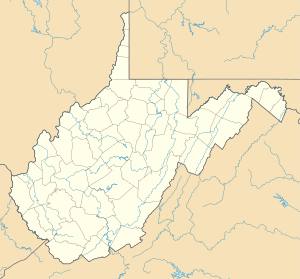Huntington (Virgínia Ocidental)
Huntington | |
|---|---|
Localidade dos Estados Unidos | |
 Centro financeiro de Huntington | |
 Huntington | |
 Huntington | |
| Dados gerais | |
| Fundado em | 1775 (243 anos) |
Incorporado em | 1871 (147 anos) |
| Localização | |
Condado | Condado de Cabell (92,58%) Condado de Wayne (7,42%) |
Estado | |
| Tipo de localidade | Cidade |
| Características geográficas | |
Área | 47,81 km² |
| - terra | 42,01 km² |
| - água | 5,80 km² |
População (2010[1]) | 49 138 hab. (1 169,68 hab/km²) |
Altitude | 172 m |
| Códigos | |
código FIPS | 54-39460 |
Sítio web | http://www.cityofhuntington.com |
Huntington é uma cidade localizada no estado norte-americano da Virgínia Ocidental, nos condados de Cabell e Wayne.
Índice
1 Geografia
1.1 Localidades na vizinhança
2 Demografia
3 Ligações externas
4 Referências
Geografia |
De acordo com o United States Census Bureau, a cidade tem uma área de 47,8 km², onde 42 km² estão cobertos por terra e 5,8 km² por água.[1]
Localidades na vizinhança |
O diagrama seguinte representa as localidades num raio de 12 km ao redor de Huntington.

Demografia |
| ||||||||||||||||||||||||||||||||||||||||||||||||||||||||||||||||||||
Segundo o censo nacional de 2010,[1] a sua população é de 49 138 habitantes e sua densidade populacional é de 1 169,68 hab/km². É a segunda cidade mais populosa da Virgínia Ocidental. Possui 25 146 residências, que resulta em uma densidade de 598,58 residências/km².
Ligações externas |
Sítio oficial (em inglês)
Estatísticas, mapas e outras informações sobre Huntington em city-data.com (em inglês)
Referências
↑ abc «GCT-PH1 - Population, Housing Units, Area, and Density: 2010 - State -- Place and (in selected states) County Subdivision» (em inglês). United States Census Bureau. Consultado em 21 de setembro de 2011
↑ «GCT-PH1 - Population, Housing Units, Area, and Density: 2010 - State -- Place and (in selected states) County Subdivision» (em inglês). United States Census Bureau. Consultado em 21 de setembro de 2011
↑ «GCT-PH1-R - Population, Housing Units, Area, and Density (geographies ranked by total population): 2000 - Geography: State -- County - State -- Place and (in selected states) County Subdivision» (em inglês). United States Census Bureau. Consultado em 21 de setembro de 2011
